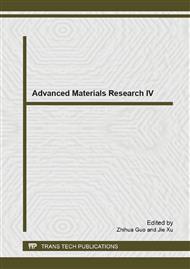[1]
Alves, C., et al., Ecodesign of automotive components making use of natural jute fiber composites. Journal of Cleaner Production, 2010. 18(4): pp.313-327.
DOI: 10.1016/j.jclepro.2009.10.022
Google Scholar
[2]
Mohanty, A.K., et al., Effect of process engineering on the performance of natural fiber reinforced cellulose acetate biocomposites. Composites Part A: Applied Science and Manufacturing, 2004. 35(3): pp.363-370.
DOI: 10.1016/j.compositesa.2003.09.015
Google Scholar
[3]
Koronis, G., A. Silva, and M. Fontul, Green composites: a review of adequate materials for automotive applications. Composites Part B: Engineering, 2012(0).
DOI: 10.1016/j.compositesb.2012.07.004
Google Scholar
[4]
John, M.J. and S. Thomas, Biofibres and biocomposites. Carbohydrate Polymers, 2008. 71(3): pp.343-364.
DOI: 10.1016/j.carbpol.2007.05.040
Google Scholar
[5]
Wambua, P., J. Ivens, and I. Verpoest, Natural fibres: can they replace glass in fibre reinforced plastics? Composites Science and Technology, 2003. 63(9): pp.1259-1264.
DOI: 10.1016/s0266-3538(03)00096-4
Google Scholar
[6]
Drzal, L.T., et al., Low-cost, bio-based composite materials for housing applications, in Advances in Building Technology. 2002, Elsevier: Oxford. pp.225-232.
DOI: 10.1016/b978-008044100-9/50028-0
Google Scholar
[7]
Faruk, O., et al., Biocomposites reinforced with natural fibers: 2000-2010. Progress in Polymer Science, 2012(0).
Google Scholar
[8]
Bledzki, A.K. and J. Gassan, Composites reinforced with cellulose based fibres. Progress in Polymer Science, 1999. 24(2): pp.221-274.
DOI: 10.1016/s0079-6700(98)00018-5
Google Scholar
[9]
Bledzki, A.K., O. Faruk, and V.E. Sperber, Cars from Bio-Fibres. Macromolecular Materials and Engineering, 2006. 291(5): pp.449-457.
DOI: 10.1002/mame.200600113
Google Scholar
[10]
De Rosa, I.M., et al., Morphological, thermal and mechanical characterization of okra (Abelmoschus esculentus) fibres as potential reinforcement in polymer composites. Composites Science and Technology, 2010. 70(1): pp.116-122.
DOI: 10.1016/j.compscitech.2009.09.013
Google Scholar
[11]
Pielichowski, K.N., James Rapra Technology Limited Staff, Thermal Degradation of Polymeric Materials. 2005, Shrewsbury: Smithers Rapra. 320.
Google Scholar
[12]
Gassan, J. and A.K. Bledzki, Thermal degradation of flax and jute fibers. Journal of Applied Polymer Science, 2001. 82(6): pp.1417-1422.
DOI: 10.1002/app.1979
Google Scholar
[13]
Yang, H., et al., Characteristics of hemicellulose, cellulose and lignin pyrolysis. Fuel, 2007. 86(12-13): pp.1781-1788.
DOI: 10.1016/j.fuel.2006.12.013
Google Scholar
[14]
J.H. v. d. Maas, Basic infrared spectroscopy LinkLondon : Heyden, (1972).
Google Scholar
[15]
Albano, C., et al., Thermal stability of blends of polyolefins and sisal fiber. Polymer Degradation and Stability, 1999. 66(2): pp.179-190.
DOI: 10.1016/s0141-3910(99)00064-6
Google Scholar
[16]
Fung, K.L., et al., An investigation on the processing of sisal fibre reinforced polypropylene composites. Composites Science and Technology, 2003. 63(9): pp.1255-1258.
DOI: 10.1016/s0266-3538(03)00095-2
Google Scholar
[17]
Wong, S., R. Shanks, and A. Hodzic, Interfacial improvements in poly(3-hydroxybutyrate)-flax fibre composites with hydrogen bonding additives. Composites Science and Technology, 2004. 64(9): pp.1321-1330.
DOI: 10.1016/j.compscitech.2003.10.012
Google Scholar
[18]
Yao, F., et al., Thermal decomposition kinetics of natural fibers: Activation energy with dynamic thermogravimetric analysis. Polymer Degradation and Stability, 2008. 93(1): pp.90-98.
DOI: 10.1016/j.polymdegradstab.2007.10.012
Google Scholar


